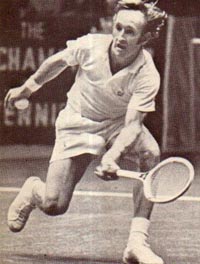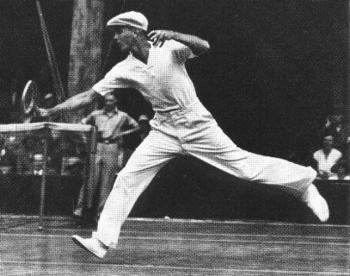|
TennisOne Lessons Punch the Volley? Daryl Fisher If you have played tennis for any length of time you have no doubt heard the classic tennis instruction to “punch the volley.” As common as this instruction is, and with such a simple presentation, you might think that it is clear and useful. Unfortunately, at least without any additional instruction, it might be neither of these things. For most people that do not already know how to punch or do not know already which of the aspects of the punch should be applied to the volley, the instruction “punch the volley” is meaningless, or worse, confusing.
The word “punch” is the challenging part, of course. Does it mean a literal physically combative punch? When I first heard “punch the volley,” I imagined a boxer making a punching motion, and then I imagined making the same motion with a racquet in my hand to volley. This image did not resemble anything that I saw touring tennis professionals doing for either forehand or backhand volleys, so the instruction seemed very strange. In the interest of using language to best help other tennis players, I began to wonder what other people thought of when they heard the instruction to “punch the volley,” so I started asking. The answers were more numerous than there are definitions of the word “punch.” From the perspective of accuracy and an attempt to foster helpful instruction, a phrase that is so amorphous and potentially meaningless yet so embedded in how people think of volleys seems worse than useless. Whenever I witness an instructor repeating the phrase “punch the volley,” my suspicion is that the students would love to comply if only they knew what the instruction meant. “Punch the volley” as a stand-alone instruction, with no additional instruction, is insufficient. At the very least, given that there are different types of punches, some explanation for the word “punch” becomes required or else it will raise more questions than it answers. Some Explanation from Two Greats Whatever Billie Jean King or Rod Laver have to say about volleys, I am eager to hear it. They were two of the greatest players ever, and were as skilled as anyone as volleyers. In talking about punching a volley, both King and Laver provide some explanation and context to the concept.
The great Rod Laver used the word “punch” in relation to volleys in his 1971 book The Education of a Tennis Player. In a photo sequence on the volley, he says to “keep the racket out in front of you and punch briskly.” In his description of the “crisp volley,” Laver also wrote:
Billie Jean King, in her book Tennis to Win, published in 1970, wrote:
What Laver and King encouraged makes sense if you consider the elements of a punch that they emphasize, a very quick preparation and compact motion that when translated to volleying amounts to a short backswing. While no decent tennis player would volley with the actual motion of what is taught as a jab or a right cross in most martial arts classes, the greats Laver and King bring some clarity to what the volley can borrow from the concept of a certain type of punch. This is far superior already to the simple phrase “punch the volley.”
More History While it appears that the instruction “punch the volley” goes back at least four decades to Laver and King, my suspicion is that neither of them invented the phrase. I suspect, rather, that they inherited the idea of “punching” just as we did. Even more, I suspect that there really were people able to volley with reasonable skill while making a punching motion similar to a right cross or a jab. Nearly every professional now volleys with the Continental grip on both the forehand and backhand sides, but if you go back to photographs from, say, the 1920s, it is clear that players at the top of the game then used a number of grips that would be considered unconventional now. In fact, in Jean René Lacoste's book published in 1928 called Lacoste on Tennis, he suggests that to volley aggressively requires multiple grips:
With the assumption of using a Continental grip for both the forehand and backhand volleys, the image of making a volley that is exactly like a punching motion does not make sense, but perhaps the idea of “punching the volley” goes so far back that with certain grips that were used prior to four decades ago, a punch and a volley really could have been similar, or the same, motions. Now re-read As much as King and Laver were excellent volleyers, and as helpful as their explanations are for what elements of punching technique can be borrowed for the sake of learning to volley, it is worth noting that if you re-read what each of them said leaving out any reference to punching, you will find that their explanations are at least as good. The concept of a punch, in fact, could distract a reader from what they are trying to convey. (To remove any talk of punching also eliminates the potentially confusing contradiction between what the two of them wrote—one wrote “jab” and the other wrote “neat right cross.”) And even if a tennis player is familiar with a right cross, there are only some elements of the motion that can be borrowed for the benefit of learning the volley. It might be somewhat telltale to note that as I have been educating myself for this article on boxing technique, no boxing instruction drew the comparison of a punch and a tennis volley. Chop While it would be acceptable to end this article simply by noting that the old tennis cliché of “punch the volley” is at least incomplete, and perhaps even misleading if the instruction is not offered with any additional explanation, I would like to go a step farther and suggest that the volley motion could be more accurately compared to a specific type of punch where the edge of the dominant hand leads the motion. The edge of the hand is the area of the hand that is opposite the thumb and between the little finger and the wrist. In martial arts, this is the area that would be used for what is called a knifehand strike, which is more commonly known as a karate chop.
In an article on stable alignment I wrote about how the bottom edge of the hand should lead a motion for the one-handed backhand. The benefit of the bottom edge of the hand leading the motion is related to keeping the wrist in a position throughout the motion that will remain stable while playing against a very strong shot. Perhaps more importantly, this wrist alignment is also highly resistant to injury. While I presented the information for leading with the bottom edge of the hand for the benefit of the one-handed backhand, the fact that leading with the bottom edge of the hand looks like a karate chop when done on a forehand or backhand volley is suddenly relevant to the topic of “punch the volley.” A punch as we usually think of it is not like a volley in the sense that we do not lead with the knuckles on a typical volley, but we do, however, lead with the bottom edges of our hands on a typical volley. For a volley hit with the Continental grip, it is also relevant to add that a “chop” is likely to impart a little backspin, which is useful for control, whereas a “punch” seems to be conducive to a flatter shot. In these ways a volley and a karate chop are much more similar than a volley and a right cross. Try it Without any explanation as to how the word “punch” has any relation to the volley, it does not mean much. Given that the word has come to mean something with regard to the volley to many great players, there must be some value to it, but perhaps the value has changed from its original meaning, and perhaps we only continue to use the word because some great player used it. The next time you go out to play, test the value of the phrase. Try to imagine a boxer’s jab or right cross, and then try to use that motion for a volley. On second thought, maybe you do not care to look that silly in public. Rather than “punching” your volley, then, try to make short “chop” and see if that is not much closer to the look of a tennis professional’s volley. With a little explanation borrowed from Laver and King regarding keeping the motion short and compact, “karate chop the volley” suddenly becomes an improvement on the tennis cliché to “punch the volley.” |



